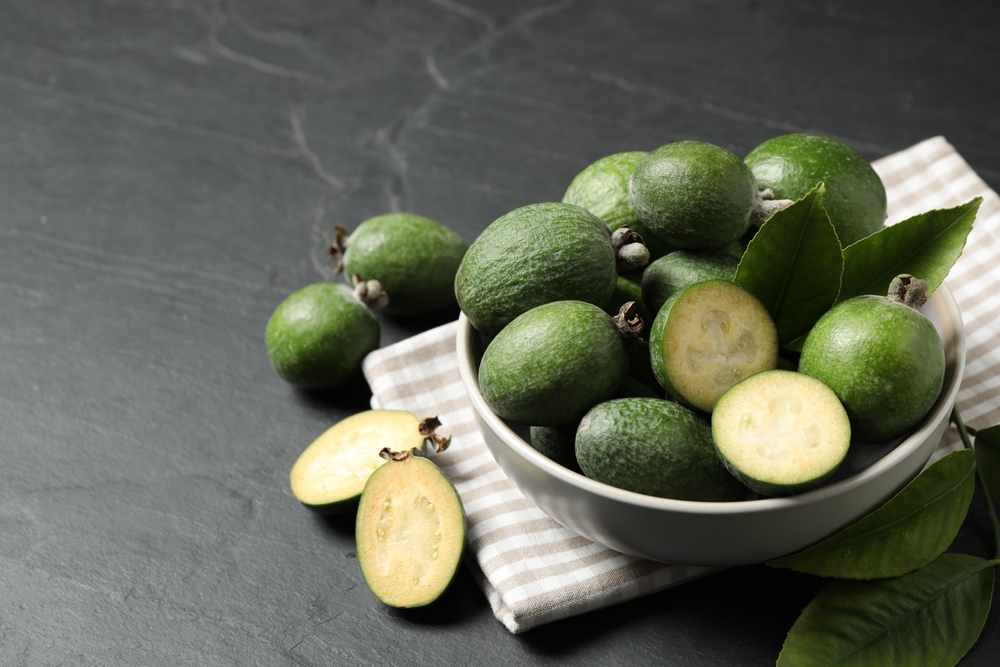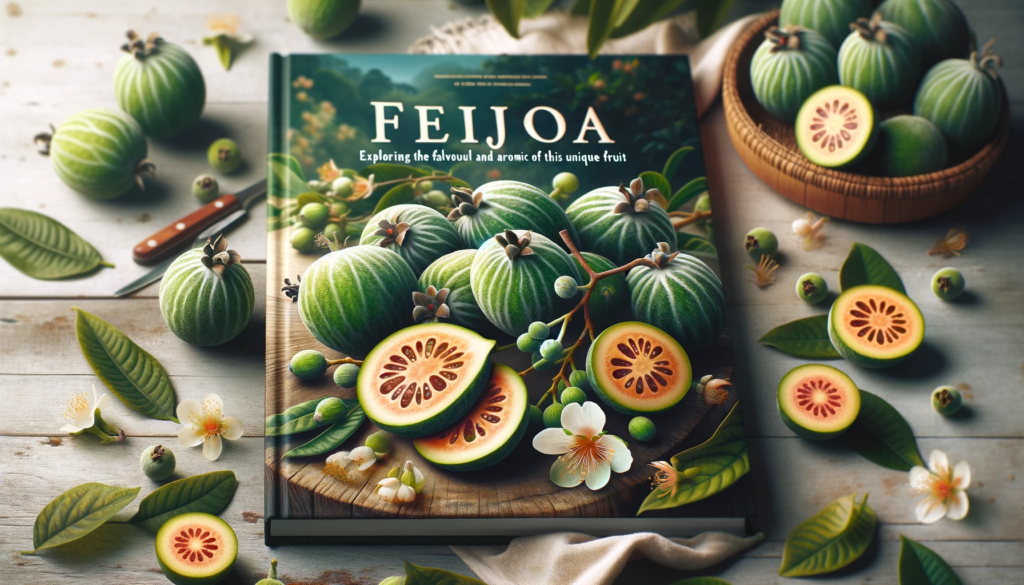Introduction to Feijoa
Understanding the Origins and Characteristics of Feijoa
Feijoa, also known as pineapple guava, is an intriguing fruit with a history and cultivation footprint that spans the globe. Originating from the highlands of South America, the feijoa is highly regarded for its rich, aromatic flavor and nutritional benefits. Traditionally, feijoas have been a part of the local diet for centuries, appreciated for their exotic taste and versatility in various culinary applications. The fruit is oval-shaped, with a rough, green skin and succulent, fragrant flesh that encases tiny, edible seeds. Although it’s relatively unknown in some parts of the world, the feijoa is celebrated for its resiliency to pests and diseases, making it a favorable option for organic agriculture. As consumer interest in exotic and healthful fruits continues to increase, feijoa offers a fresh, distinctive option that caters to the palate and well-being.
The Distinctive Flavor Profile of Feijoa
Describing the Taste and Aroma of Feijoa
The taste of feijoa is an enchanting orchestration of flavors that draws in those who are adventurous in their culinary pursuits. Often likened to a combination of pineapple, guava, and strawberry, this fruit offers a unique and delightful palette experience that is simultaneously sweet and tart. The aroma is equally captivating, resembling a tropical bouquet with a sharp, minty undercurrent. The flesh is juicy and granular, providing an appealing contrast to its soft and succulent nature. These distinct qualities of taste and aroma signify the feijoa as a specialty fruit, one that offers a remarkable and unforgettable gustatory journey. This journey is just as pleasing to the nose as it is to the taste buds.

Nutritional Benefits of Feijoa
Health Advantages and Key Nutrients Found in Feijoa
Feijoas are not only applauded for their unique taste but also for their array of health benefits. They boast a significant amount of vitamin C, a pivotal antioxidant that strengthens the immune system, aids in the absorption of iron, and promotes skin health. Additionally, feijoa is a good source of dietary fiber, essential for maintaining healthy digestion and reducing the risk of chronic diseases. It contains a host of vital nutrients such as vitamin A, an assortment of B vitamins, and minerals like potassium, magnesium, and iodine. With a profile rich in antioxidants and phytonutrients, consuming feijoas is linked to protective effects against oxidative stress and inflammation, rendering it a power-packed addition to one’s diet.
Culinary Uses of Feijoa
Various Ways to Incorporate Feijoa in Dishes
Creative cooks savor the feijoa for its versatility and unique flavor, which enriches many dishes. This fragrant fruit can be effortlessly consumed raw or incorporated into diverse culinary creations. Feijoas make an excellent addition to fruit salads, lending a tropical vibe with their distinct flavor. They can be pureed into smoothies for a nutrient-dense treat or transformed into delectable chutneys and jams that pair remarkably well with meats and cheeses. Feijoas also bake beautifully, adding a moist and aromatic touch to cakes, muffins, and pies. For those feeling experimental, feijoas can be used as a garnish or infused into syrups, elevating cocktails and desserts with its unique essence.
Sweet and Savory Recipes Featuring Feijoa
The captivating taste of feijoa shines equally in both sweet and savory recipes. Home bakers can delight in preparing feijoa loaf, where the fruit’s succulent nature contributes to a rich, moist texture heightened with hints of nutmeg and cinnamon. Another tempting option is feijoa crumble, pairing the juicy flesh with a buttery topping for a comforting dessert. On the savory spectrum, feijoa can be turned into a lively salsa, complementing grilled fish or chicken, or blended into a smooth sauce that adds sweetness to roasted pork. The adventurous might even incorporate feijoas into savory tarts or pair them with leafy greens in a refreshing salad, proving that this diverse fruit’s culinary potential knows no bounds.
Growing and Harvesting Feijoa
Best Practices for Cultivating and Picking Feijoa
For horticulture enthusiasts keen on adding feijoa to their home gardens, understanding the best practices for its cultivation and harvest is vital. Feijoa trees flourish in well-drained soil and require a sunny to partial shade position, proving surprisingly frost-tolerant. When planting, ensure adequate space between trees to allow for optimal growth and airflow. Regular watering, especially during the flowering and fruiting seasons, is critical to ensure a bountiful harvest. The feijoa is unique in that the fruit falls from the tree when ripe, so daily collection from the ground under the tree is a common harvesting method, reducing the need for hands-on picking and promoting natural ripeness indicators for peak flavor and nutrition.

Preserving and Storing Feijoa
Techniques to Extend the Shelf Life of Feijoa
Once harvested, preserving the freshness of feijoas becomes an essential task. The delicate nature of the fruit requires careful handling and prompt refrigeration to extend its shelf life. Feijoas can be kept at room temperature for a few days, but storing them in the refrigerator’s crisper drawer can preserve their quality for up to two weeks. For long-term storage, feijoas can be scooped out and frozen, ideally with a touch of acid like lemon juice to maintain their vibrant color and flavor. Another method is to convert the fruit into a puree or compote, which can be canned or frozen, securing the essence of feijoa for future culinary endeavors. Drying or dehydrating feijoas is yet another alternative, creating a chewy, sweet snack that retains most of the fruit’s original nutrients.
Feijoa in World Cuisine
How Different Cultures Utilize Feijoa in Cooking
The charm of feijoa is global, with various cultures incorporating this fragrant fruit into their signature dishes. It’s a celebrated ingredient in crumbles, cakes, and even traditional Maori dishes in New Zealand, where feijoas have become a fixture in backyards and cuisines. In Russia and Eastern Europe, where the fruit is admired, feijoas are commonly used in desserts, preserves, and liqueurs, ensuring its unique flavor is enjoyed year-round. Additionally, in South American countries, where the feijoa’s journey began, locals consume it fresh or as a juice, often touting its medicinal properties. The versatility of feijoa is celebrated internationally, bringing a touch of aromatic sweetness to myriad culinary traditions, demonstrating its universal appeal.
Pairing Feijoa with Other Foods and Drinks
Complementary Flavors and Ingredients for Feijoa
Regarding pairing, feijoa proves to be a flexible and harmonious companion to a range of flavors. Its unique taste profile complements creamy dairy products like yogurt and mascarpone, enhancing desserts like panna cotta and cheesecakes. Feijoa pairs beautifully with berries and citrus, balancing sweet and tart dimensions in salads, jams, and tarts. Considering savory pairings, feijoa’s acidity and sweetness make it an excellent match for rich meats such as pork and duck, while its vibrant flavor pairs nicely with the herbaceous notes of cilantro and mint. In beverages, feijoa can be used to craft refreshing cocktails, smoothies, or simply infused in water, adding an exotic twist to hydration.
How to Tell When Feijoas are Ripe
Determining the ripeness of feijoas is straightforward. Like a ripe avocado, a ripe feijoa will yield slightly under gentle pressure. Its fragrance is a reliable indicator—ripe feijoas emit a sweet, aromatic perfume, a sign they’re ready to be enjoyed. The color should be a vibrant green, although some varieties may have a slight yellowish tinge when ripe. Avoid fruit with blemishes or soft spots. If in doubt, taste a small slice; a ripe feijoa has a balanced sweet and tangy flavor.
Selecting Feijoas for Cooking and Baking
When selecting feijoas for culinary use, the best choice is ripe yet firm fruit. This ensures they hold up well during cooking, maintaining their distinct flavor and textural integrity. Riper feijoas tend to be softer and are excellent in applications where they will be mashed or pureed, such as smoothies, jams, or dessert fillings. For items like salads or garnishes where structure is desirable, opt for slightly firmer feijoas.
Preparing Feijoas for Consumption
Preparing feijoas is simple and can be done in various ways depending on the intended use. Cut the feijoa in half and scoop out the insides with a spoon to enjoy the flesh. The entire fruit is edible, including the skin, which can be consumed raw or used to add zest to dishes. If preferred, peel the skin and dice the flesh for use in recipes. The delicate seeds inside are also edible and provide a subtle crunchy texture.
Enhancing Flavor Profiles with Feijoa
The vibrant flavor of feijoa can enhance a wide array of dishes. For an intensified feijoa flavor, incorporate the flesh and the finely grated skin into your recipes. The skin adds a zesty element, perfect for infusing sugars or salts. You can also boil the skins to make a flavorful syrup for drinks or desserts. Even the flowers of the feijoa tree are edible, offering a mild taste and a splash of color to salads and garnishes.
Storing and Preserving Feijoas for Longevity
To store feijoas, place them in the refrigerator where they can last for approximately two weeks. For longer preservation, freeze the flesh on a baking sheet before transferring to an airtight container, or make a puree with a bit of lemon juice to prevent browning. Canning feijoas for jams or jellies is another excellent way to enjoy their flavor all year round. Feijoas can also be dehydrated into a dry fruit snack or fruit leather. As with all fruit, ensure proper sealing to maintain freshness and flavor.
Utilizing Surplus Feijoas
If you find yourself abundant feijoas, there are several ways to use them. Beyond fresh consumption, you can bake feijoa muffins or bread, create jams or compotes, or craft delicious chutneys. Feijoa pulp can be added to pancake or waffle batter for a fruity twist. Experiment with feijoa-infused vinegar for salad dressings, or consider brewing feijoa wine or cider. You can also gift surplus feijoas to friends and family to share the joy of this unique fruit.
Embark on a culinary adventure with our guide to the indigenous ingredients in Oceania. Explore flavors that define an entire region!
